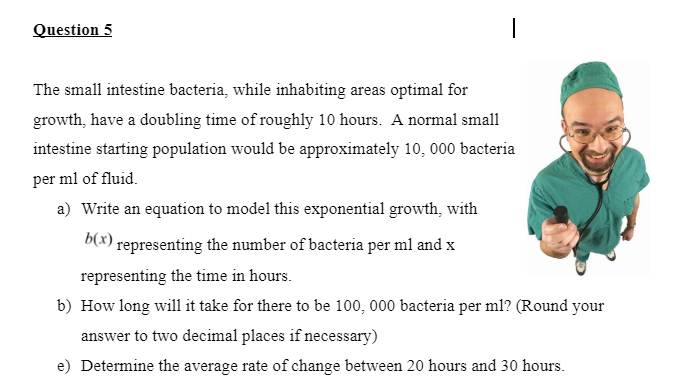The small intestine bacteria, while inhabiting areas optimal for growth, have a doubling time of roughly 10 hours. A normal small intestine starting population would be approximately 10, 000 bacteria per ml of fluid. a) Write an equation to model this exponential growth, with b(x) representing the number of bacteria per ml and x representing the time in hours. b) How long will it take for there to be 100, 000 bacteria per ml? (Round your answer to two decimal places if necessary) e) Determine the average rate of change between 20 hours and 30 hours.
The small intestine bacteria, while inhabiting areas optimal for growth, have a doubling time of roughly 10 hours. A normal small intestine starting population would be approximately 10, 000 bacteria per ml of fluid. a) Write an equation to model this exponential growth, with b(x) representing the number of bacteria per ml and x representing the time in hours. b) How long will it take for there to be 100, 000 bacteria per ml? (Round your answer to two decimal places if necessary) e) Determine the average rate of change between 20 hours and 30 hours.
College Algebra
7th Edition
ISBN:9781305115545
Author:James Stewart, Lothar Redlin, Saleem Watson
Publisher:James Stewart, Lothar Redlin, Saleem Watson
Chapter4: Exponential And Logarithmic Functions
Section: Chapter Questions
Problem 11T: Suppose that $12,000 is invested in a saving account paying 5.6% interest per year. (a)Write the...
Related questions
Topic Video
Question
The question is in the image

Transcribed Image Text:Question 5
The small intestine bacteria, while inhabiting areas optimal for
growth, have a doubling time of roughly 10 hours. A normal small
intestine starting population would be approximately 10, 000 bacteria
per ml of fluid.
a) Write an equation to model this exponential growth, with
b(x) representing the number of bacteria per ml and x
representing the time in hours.
b) How long will it take for there to be 100, 000 bacteria per ml? (Round your
answer to two decimal places if necessary)
e) Determine the average rate of change between 20 hours and 30 hours.
Expert Solution
This question has been solved!
Explore an expertly crafted, step-by-step solution for a thorough understanding of key concepts.
This is a popular solution!
Trending now
This is a popular solution!
Step by step
Solved in 2 steps

Knowledge Booster
Learn more about
Need a deep-dive on the concept behind this application? Look no further. Learn more about this topic, advanced-math and related others by exploring similar questions and additional content below.Recommended textbooks for you

College Algebra
Algebra
ISBN:
9781305115545
Author:
James Stewart, Lothar Redlin, Saleem Watson
Publisher:
Cengage Learning

Algebra and Trigonometry (MindTap Course List)
Algebra
ISBN:
9781305071742
Author:
James Stewart, Lothar Redlin, Saleem Watson
Publisher:
Cengage Learning

Linear Algebra: A Modern Introduction
Algebra
ISBN:
9781285463247
Author:
David Poole
Publisher:
Cengage Learning

College Algebra
Algebra
ISBN:
9781305115545
Author:
James Stewart, Lothar Redlin, Saleem Watson
Publisher:
Cengage Learning

Algebra and Trigonometry (MindTap Course List)
Algebra
ISBN:
9781305071742
Author:
James Stewart, Lothar Redlin, Saleem Watson
Publisher:
Cengage Learning

Linear Algebra: A Modern Introduction
Algebra
ISBN:
9781285463247
Author:
David Poole
Publisher:
Cengage Learning


Algebra & Trigonometry with Analytic Geometry
Algebra
ISBN:
9781133382119
Author:
Swokowski
Publisher:
Cengage

Trigonometry (MindTap Course List)
Trigonometry
ISBN:
9781337278461
Author:
Ron Larson
Publisher:
Cengage Learning